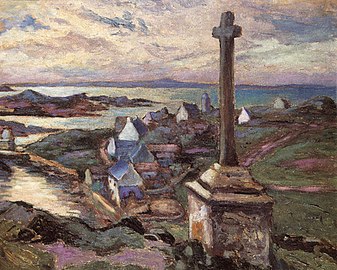Allan Österlind

Erik Allan August Österlind (2 November 1855, Stockholm – 23 June 1938, Juvisy-sur-Orge) was a Swedish painter and engraver who spent most of his life in France.[1]
Biography

He was born to a family of the Swedish nobility and his father was a wholesale merchant. From 1874 to 1875, he studied at the
In 1878, he enrolled at the
In 1884 he, Josephson and Richard Bergh held a joint showing in Stockholm and, two years later, in Gothenburg. The following year, he became a signatory to an anti-Academy manifesto issued by a group known as the "Opponenterna". Despite opposition from King Oscar II, he and other Swedish expatriates participated in the Exposition Universelle (1889), and he was awarded a silver medal.[2]
That same year, he married Joséphine Eugénie Carré (1862-1916), thereby legitimizing their two children, Anna Alina (born 1882) and Anders, who would also become a painter. As a result, he remained in France for the rest of his life, although he never gave up his connections to Sweden and maintained a regular correspondence with Prince Eugen..
In 1890, he ceased participating in showings at the regular salons and became a member of the
The start of World War I and the death of his wife two years later left him in a state of depression and he spent more time travelling. He also began a curious collection of portrait paintings of the inhabitants of the Île-de-Bréhat, done on glasses and plates, at a local cabaret called the "Café des Pêcheurs". Apparently, unable to pay his bill, he had painted a portrait of himself as compensation. Several artists followed suit and the Café became known as the "Cabaret des Décapités". Some of them may still be seen at the Verrerie.[3]
He died in poverty in 1938. His works may be seen at the
Selected works
-
The Servants
-
The Houses of Bréhat
-
Children Playing
-
Rodinin His Studio
References
- ^ Obituary, Dagens Nyheter, 25 June 1938 pg.7
- ^ Journal officiel de la République française, 29 septembre 1889.
- ^ Le Décapités de Bréhat @ Le Petit Futé.
- ^ Journal officiel de la République française, 1 September 1913}
- ^ Journal officiel de la République française, 20 December 1918
External links
- More works by Österlind @ ArtNet
- Biography @ the Lexikonett Amanda
- Allan Österlind, biography and virtual museum, @ the Anders Österlind Association.




